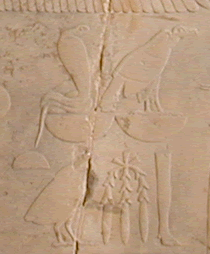| Homepage | Timeline | Maps | A-Z index | Learning |
The two ladies
The two ladies (nebty) are the representations of Lower and Upper Egypt.
 |
|
the nebty name of Amenemhat
I
|
The 'two ladies' are two goddesses:
Nekhbet ('she who belongs to Nekheb'- Elkab)
- the vulture, the goddess of Upper Egypt
Wadjet ('the green one') - the cobra, who was worshipped in Buto and was the
goddess of Lower Egypt.
In some writings the cobra and vulture are replaced by the crowns of Lower and Upper Egypt.
The 'two ladies' appear already under king Aha in the First Dynasty (on a tablet found in a mastaba at Naqada). It is debated if this early attestation refers to a king's name. The 'two ladies' are placed on this tablet inside of a building. It might be in this case just the name of a building and not a royal name. The name is securely attested for the first time under Semerkhet (First Dynasty) as part of the titulary of the king's name. However, in the Old Kingdom (about 2686-2181 BC) the 'two ladies' are often part of a name and not a title. The name is most often identical or very similar to the Horus name.
Only in the Twelfth Dynasty under Senusret II did the name become independent. The Nebty name of the king is different to his Horus name.